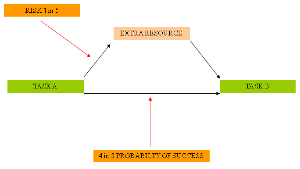Risk management - Quantitative method part 2
Quantitative method part 2
Let’s take a simple example of TASK A going to TASK B.
If there is no possibility of anything going wrong (clearly not the real world) then there would be a 100% success rate in carrying out the task.
However, the project team (or manager assessing the task) may take the view (based upon experience) that there is, say, a 1 in 5 chance (20%) that the task will not complete. Or putting it another way there is a 4 in 5 chance (80%) that it will succeed.
If the task does not complete then it will take extra resource to correct.
Let’s assume the task was meant to take 6 weeks. It may judged by the project team that it will take another 4 man weeks to sort out if there are problems.
Note: That this in no way is a prediction of what will actually go wrong, rather an experienced estimate that it is likely to take a certain period of time to correct.
However, if you add extra resource to the task up front to reduce this risk then there may be more chance of success. In other words you REDUCE THE RISK or MITIGATE the potential impact.
It may well be that with the extra resource you judge that the risk has been reduced to, say, 1 in 10 (10%).
In the above example, you could apply, say, 2 men each week to bring the expected extra 4 weeks (one man only) down to a 2 week period.
Therefore there would only be a 2 week delay.
Costs involved are examined in more detail elsewhere [see Quantitative part 3].



